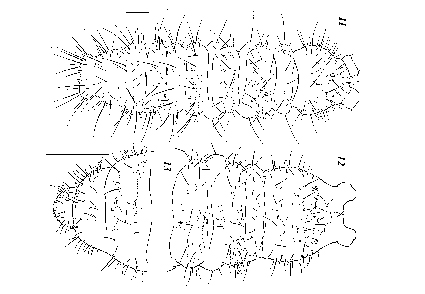Abstract
A new species of the genus Anurida is described and illustrated based on material from the Khabarovsk Territory, Russia: A. hirsuta sp. nov. This new species belongs to the amphi-Pacific hammerae-group and it seems to be particularly similar to the Beringian A. hammerae Christiansen, 1952 and the Japanese A. trioculata Kinoshita, 1916. Anurida hirsuta sp. nov. can easily be distinguished from both latter species primarily by its peculiar dorsal chaetotaxy, apparently the most complete among all congeners. A key is presented to all eight species presently known to compose the group.
References
Axelson, W.M. (1902) Diagnosen neuer Collembolen aus Finland und angrenzenden Teilen des nordwestlichen Russlands. Meddelanden af Societatis pro Fauna et Flora Fennica, 28, 101–111.
Babenko, A.B., Shveenkova, Yu. B. & Kuznetsova, N.A. (2019) New species of the genus Anurida (Collembola, Neanuridae) from the Far East of Russia. Zoologicheskii Zhurnal, 98 (2), 130–148. https://doi.org/10.1134/S004451341902003X
Christiansen, K.A. (1952) Notes on Alaskan Collembola. II. Three new species of Arctic Collembola. Psyche, 58 (4), 125–140. https://doi.org/10.1155/1951/13918
Deharveng, L. (1983) Morphologie évolutive des Collemboles Neanurinae en particulier de la lignée Néanurienne. Travaux du Laboratoire d’Ecobiologie des Arthropodes Edaphiques, Toulouse, 4 (2), 1–63.
Fjellberg, A. (1985a) Arctic Collembola. I. Alaskan Collembola of the families Poduridae, Hypogastruridae, Odontellidae, Brachystomellidae and Neanuridae. Entomologica Scandinavica, Supplement 21, 1–126.
Fjellberg, A. (1985b) Elements of dorsal chaetotaxy in Neanuridae with descriptions of two new species of Anurida (Collembola). Entomologica Scandinavica, 15, 349–362.
Hasegawa, M. & Tanaka, S. (2013) Classification of the family Neanuridae (Hexapoda: Entognatha: Collembola) from Japan 2. Subfamilies Brachystomellinae Massoud, 1967, Odontellinae Massoud, 1967, Frieseinae Massoud, 1967 and Pseudachorutinae Massoud, 1967. Edaphologia, 92, 37–73. [in Japanese]
Kinoshita, S. (1916) On the Japanese Collembola. Dobutsugaku zasshi [Zoological Magazine, Tokyo], 28, 451–460. [in Japanese]
Laboulbène, A. (1865) Recherches sur l’Anurida maritima, Insecte Thysanoure de la famille des Podurides. Annales de la Société entomologique de France, 4 (4), 705–720.
Lee, I. & Park, K.-H. (2016) Cave species of the genus Anurida (Collembola: Neanuridae) from Korea, with the description of new species. Zootaxa, 4184 (3), 589–599. https://doi.org/10.11646/zootaxa.4184.3.12
Uchida, H. (1951) On two species of the genus Anurida (Collembola), A. trioculata and A. granaria. Kontyû, 19, 32–35. [in Japanese]
Yosii, R. (1954a) Die Kulturpflanzenschädigenden Collembolen Japans. Oyo-Kontyû, 10, 137–141.
Yosii, R. (1954b) Hӧhlencollembolen Japans. I. Kontyû, 20 (3–4), 14–22.
Yosii, R. (1956a) Hӧhlencollembolen Japans. II. Japanese Journal of Zoology, 11, 609–627.
Yosii, R. (1956b) Monographie zur Hӧlencollembolen Japans. Contribution from the Biological Laboratory, Kyoto University, 3, 1–131.
Yosii, R. (1966) Results of the speleological survey in South Korea 1966. IV. Cave Collembola of South Korea. Bulletin of the National Science Museum, Tokyo, 9, 541–561.
Yosii, R. (1970) On some Collembola of Japan and adjacent countries II. Contribution from the Biological Laboratory, Kyoto University, 23, 1–32.
Yosii, R. (1971) Collembola of Khumbu Himal. Khumbu Himal, 4 (1), 80–130.


